The prettiest things right in front of our eyes often go unnoticed, sometimes literally too. At the tulip festival of Kashmir the milling crowd rarely took a second look at the nearly 20 lakh blooms spread over 30 hectares of lush acreage sweeping into the foothills of the Great Himalayan range. Instead, they busied themselves taking photographs of each other in insta-like poses and I was occupied watching them, marvelling at the brazenly doting couples in a normally conservative place. Newly-weds and lovers went to the farthest corners of the Indira Gandhi Memorial Garden with the Pir Panjal hovering above while families plonked themselves down boisterously next to the fountain at the centre, their spirited tohubohu drowning out the sound of splashing water. In the midst of this photo-posing-and-taking fracas the only one taking any note of the flowers – often toppling over the fences homing in on the petals and pistils – was my girlfriend, a hobby florist on a mission to find peonies in the Valley. Wrong time of the year, went the refrain which she wasn’t buying.
A mandatory note on the peony: Despite my mother being a prize winning florist in her heydays – and I being the handyman transporting her wares to and from exhibition stalls, I was no floral cognoscente – this was the first time I heard of the flower. Peonies are perennials, or simply plants that flower for many growing seasons, some even going on for a century or more. They are popular for being hassle-free when the climate is salubrious, of bounteous beauty and a subtle, elegant fragrance. Looking like a cross between a tulip and a rose, it’s a copious burst of petals, almost haywire from a distance. It doesn’t wait for your love but sits nonchalantly like some famous courtesan assured of her desirability and least coy about the power she will wield over you once you are within eye-locking distance.
Her irrefragable reasoning was a visit almost a decade ago; same time of the year when she first saw the peony and fell head over heels in love with it. A love that only grew stronger over the years with the flower becoming the centrepiece of many of her own creations and sending half of the Ghazipur flower market into a procurement tizzy. Not that she was exactly a simpatico but one had to be an insufferable drab to question anyone’s memories of lasting loves – I joined her in shaking my head at anyone who said we had to wait another month, till May. Which was everyone.
“The agriculture university might have them,” said one official at the tulip festival who had by then begun to kick himself for letting us in through the VIP entry where there was no queue or ticket. Used to muster up endless supplies of chai and biscuits for guests arriving in bugled vehicles, the demand for the one missing flower amid so many seemed to have jarred him. “We call this the tulip festival for a reason,” I half expected him to put it bluntly. Had it been anywhere other than Kashmir he might have, too. The people here are exceedingly hospitable; riding around Srinagar, invites to meals had become the norm. They seldom say ‘no’ and hearing it from others is just short of daunting.
Nursery and college
The Sher-e-Kashmir agricultural university reminded me of the bus depot at Reckong Peo: when surrounded by such plentiful natural beauty, the facility, however functional or aesthetic, strikes you as a blot to the landscape. Low slung buildings permeated reclaimed fields of the mountainous Shalimar; older of the lot reflected the ornate architecture of the land while the newer ones were as artful as blocks of ice. The campus was so expansive and removed from the main drag that students were content in their own little worlds of amity and academia. A girl who was sketching a wild flower while talking animatedly into her phone directed us via gestures to the university’s green house. The gardener was promptly declared a confrere and all his wards as esculent; soon enough we had somebody who would lay down his life for us, sacrifice his family for our pursuit. But still, it was too early for peonies. A variety of the plant burst out from a neatly laid out ground but the stems were freshly pruned and nodes poked like raindrop pricks.
“Can you come back in May?” asked the caretaker. Mutant Covid strains had by now made a robust resurgence; cases in the valley were spiking exponentially and footfalls to the flower show continued in thousands each day. There was no question of whether a lockdown – only when and for how long. (Curfew and in turn lockdown were declared in Kashmir early May and at the time of writing, extended till the 17th.) Alternatively, he suggested, we could also check out the smaller gardens along the Dal.
Most of the flower nurseries along the Dal Lake are like nurseries anywhere – prime property in a fragile or tony zone, bound by eco rules or law suits and manned by labourers from Bihar or UP with managers missing. Their frontages were just a hop-skip wide but plants were stacked all the way to mountains bases on the inside. A habitual livewire, sights of plants and flowers made my girlfriend an ecstatic livewire. Her soubrette-like ebullience by then had made many blush with anticipation and eye me with gravid thoughts. She summoned the managers at many of these places with such urgency that they rushed from wherever fearing the worst like land re-possession drives only to be met with intrepid questions about the missing bloom. If it weren’t for her disarming charm, infectious laughter and insouciance doled in an endearing naiveté, I’d have to keep my motorcycle revving in many places. My propensity to get into sticky situations in Srinagar was a granted by then – only a few days earlier I had gotten into a squeeze taking selfies at a bar in Srinagar (the only one that was open). Immediately surrounded by scowling men, what I didn’t know was that it was a holy period for abstinence and none of us were supposed to be there.
By now used to resigned looks at the mention of the peony I began to take these futile raids as heuristic missions and thoroughly enjoyed the lessons. Not that I would remember much later – amnesia creeping with middle age – still the carnations, lilies, hydrangeas and roses in their many bursting avatars prompted me to offer to explore more of the nearly 300 nurseries dotting the Valley for the elusive bloom – which would soon reveal itself, nothing short of a trouvaille.
To paraphrase a much-cited travel quote, just when you have looked everywhere and nearly given up it appears right under your nose. We finally found the peony at the Dak Hermitage, an atmospheric heritage homestay by the Jhelum, next to the Abdullah Bridge. Of course, we had no idea that it would be there – a charming happenstance we interpreted in more ways than sheer luck. Peeping over the lake from a dip across the road, the house is in its own carefully tended georgic settings, nothing short of a lulu among homestays. Danish, while not cryptically – and at times a tad cynically – summing up history and current happenings, tends to time at his woodwork laboratory or, with wondrous consequences, at the garden adjoining the patio. And Sana, esprit and elegant, has the vastest repertoire of stories that rarely come out of the Valley – those of introspection, the true catalysts of change.
One of her stories that stayed revolves around the horrendous floods that ravaged Kashmir in 2014. With the first floor of her house under water, having lost hundreds of books, clothes and furniture, with no power supply or potable water, washing utensils at a public tap near the Jhelum was a necessity as well as catharsis – where you focus intently, forgetting everything else so as not to damage the crockery. One day while she was at it a boatman mistaking her for one of his own ilk enquired whether she had any food left in her boat house. “Not that we needed another disaster like this as a leveller,” she pointed out distant voiced, “but it also opened our eyes to the futility of amassing possessions, planning, even looking forward with any extraordinary anticipation.” Sana left the riverine supply in tears – she had little food even at home to spare.
When I wrote – along with others – the first ever handbook for homestays in India brought out by the Times of India, I personally visited most of the places I reviewed. Among my top-most checklist was how hands-on were the hosts in its running – if the personal touch didn’t matter, you had umpteen options from spotless, supernal properties run with a clinical efficiency. At the Dak, you had all the freedom to be left to yourself, soak in the quietude in little niches decked with traditional silverwares or nooks with upcycled wooden desks with arresting epergnes. Or you could commingle with the hosts with such ease that raillery became the order of the stay.
Our Srinagar sojourn what was to be a week got extended to two because we spotted a peony bud in the garden; while perennials can be expected to be in an understandable hurry, here they were also responding to gentle cajoling and great caring. Probably aiding our own cause were unseasonal rains which also gave us all the free time to peer closely, sniff, kiss and photograph them every day, a subtle coaxing. The day it bloomed – a heady rush of populated petals looking like modular origami – sparked joyous tears, brittle hugs and delirious prancing baffling the frisky pet dogs.
Tea came in a vintage ceramic pot with real gold border; cigarettes, stories, music and laughter. Anxieties disappeared, frays smoothed and redivivus relationships shone through an overcast day.
(Most photographs courtesy of Sana Javeid and Payal Jaggi.)


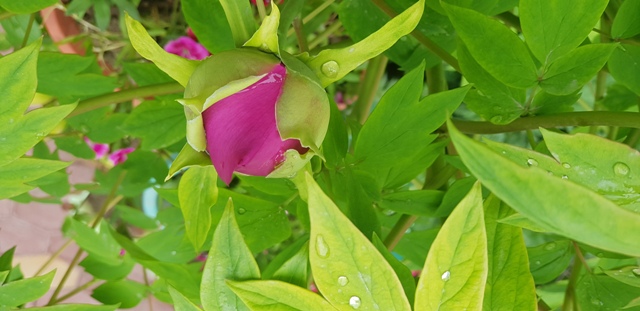

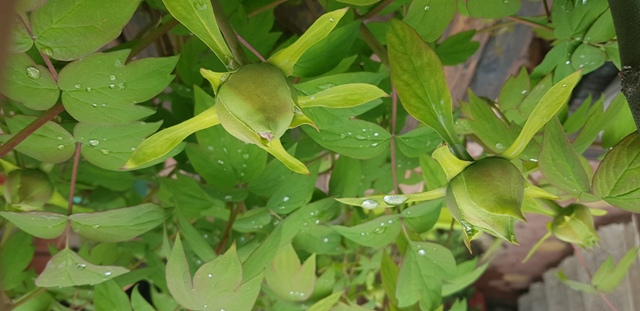


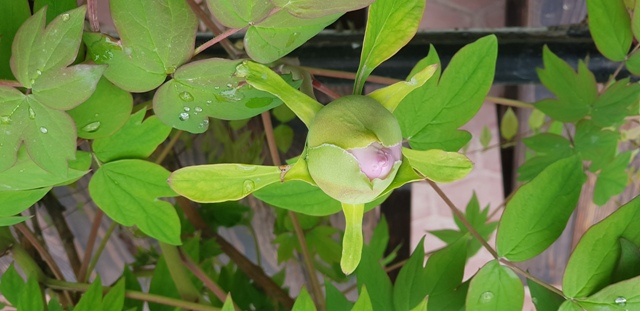

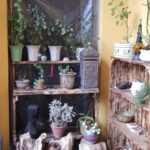



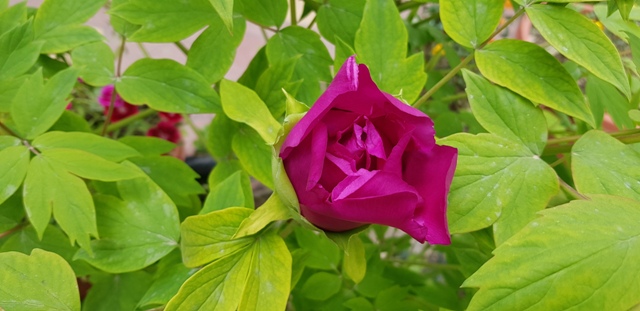









Hi,
Tulips are a really beautiful rear flower personally, I like them and in Kashmir, 30 hectares land view of tulip will be really amazing and colorful to watch. This was really a very beautiful blog.
Thank you for sharing.